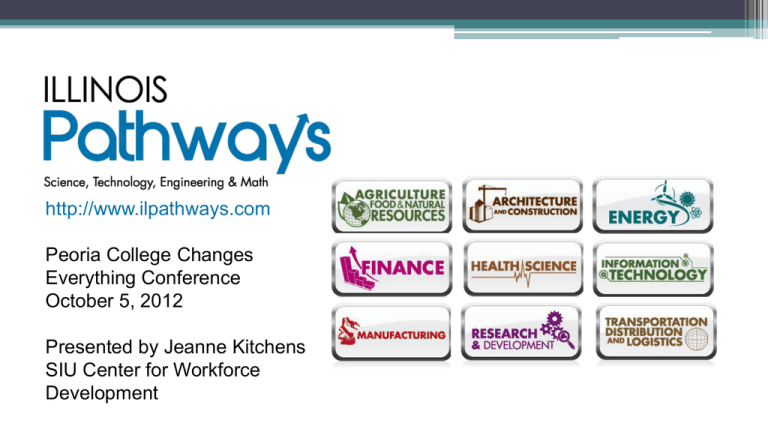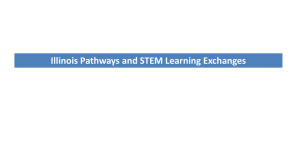Illinois Pathways – STEM Fields
advertisement

http://www.ilpathways.com Peoria College Changes Everything Conference October 5, 2012 Presented by Jeanne Kitchens SIU Center for Workforce Development State of Illinois Initiative Several state agencies are working together to coordinate education and workforce development initiatives. The Illinois Pathways initiative is designed to support college and career readiness for all students. Illinois Pathways provide a framework for recommended course sequences that require Science, Technology, Engineering, or Math courses. The pathways lead to careers that have a great need for qualified workers in our state. • Illinois Pathways were announced in February 2012. • Illinois Pathways Science, Technology, Engineering, and Math (STEM) Learning Exchanges were announced in September 2012. • Funding for Illinois Pathways program support is through the state’s Race to the Top (RttT) Round 3 grant and Workforce Innovation Fund. Illinois Department of Commerce and Economic Opportunity Illinois State Board of Education Illinois Community College Board Illinois Board of Higher Education Illinois Student Assistance Commission Illinois Department of Employment Security Why Illinois Pathways? • Respond to changing economy. • Strengthen talent pipeline. • Improve education and training programs that lead to highgrowth careers in areas that require Science, Technology, Engineering, and/or Math. • Coordinate public and private-sector education investments. • Increase school completion rates. • Grow businesses in Illinois. • Employ more workers in high-growth careers. Research http://www.ilpathways.com Define education framework. Provide support to local education programs. State initiatives coordinated to facilitate local economic growth. Grow Economy: • Start and expand business • Hire more qualified workers Background - P-20 Council’s Goal Provides a strategy to help achieve the P-20 Council’s goal that by 2025, at least 60 percent of Illinois residents attain either: • high-quality academic degree • industry recognized certificate or credential 50% 40% 60% Background - Design Designed to build off of best practices developed under Illinois State Board of Education and Illinois Community College Board approved career and technical education (CTE) programs to: • Increase student achievement. • Improve graduations rates. • Improve transition rates to college and employment. • Originally developed and implemented as part of CTE, the nine P-20 STEM Programs of Study serve as a model for bridging programs across education institutions. 7 Background – Governance Model Illinois Pathways Interagency Committee Goal: To create a new, innovative publicprivate education infrastructure that can advance college and career readiness by coordinating statewide networks of P-20 education partners, business, labor, and other organizations based on career clusters. Illinois Pathways Advisory Council Pathways Resource Center AGR Learning Exchange MFG Learning Exchange TDL Learning Exchange IT Learning Exchange R&D Learning Exchange EGY Learning Exchange FIN Learning Exchange A&C Learning Exchange HS Learning Exchange Background – RttT Expectation for STEM Programs of Study STEM Programs of Study and Individual Learning Plans (D9) “For districts serving grades 9-12, the district establishes two or more Programs of Study promoting critical STEM application areas; for other districts, as applicable, the district establishes an individual learning plan program, commencing in 7th grade, that aligns to a Programs of Study model in the predominant feeder schools for high schools implementing STEM Programs of Study.” • Grades 9-12: Research and select two Programs of Study • Grades 7-8: Research and select an individual learning plan model • Pilot “individual learning plan” model in 2013 – 2014 • Full implementation in 2014 – 2015 NOTE: For K-8 districts, predominant feeder schools for high schools that have Programs of Study – not just STEM Programs of Study, are required to develop an individual learning plan program. • STEM Programs of Study Define education framework. Education Framework P-20 STEM Programs of Study are organized around nine career clusters and feature a series of orientation and advanced pathway courses across education institutions. • The pathways offer opportunities for students to enrich their learning through work-based learning experiences as well as demonstrate their competence through assessments and industry credentialing. • Designed to improve access and success for underrepresented populations in STEM fields, such as females, minorities, low-income, and disabled students. Notes: • Energy is a new cluster to be explored. • P-20 STEM Programs of Study also fully align to the design elements for CTE Programs of Study, including Leadership, Organization & Support; Access, Equity & Opportunity; Alignment & Transition; Enhanced Curriculum & Instruction; Professional Preparation & Development; and Program Improvement 11 & Accountability. Education Framework Public-private partnerships worked together and developed the statewide models for each of the nine P-20 STEM Programs of Study. These models established shared definitions that will support statewide networks and facilitate connections between public-private partners in each of the nine areas. Components of the reports include: • Career Profiles (Demand) • Baseline Analysis (Supply) • P-20 Course Sequence and Definition Model (Course Outline) 12 Education Framework - Attributes Cluster Selection Identified based on economic development need and community objectives. Personalization Education and career plan aligned to academic and career interests. Applied Learning Access to work-based learning opportunities. Orientation & Shared Pathway Courses Foundational skills across clusters and reduced switching costs. Early College Dual credit in “gateway” courses to improve transfer and reduce costs. College & Career Readiness Assessments 1) Academic, 2) Career, and 3) Technical. Professional Development Training and work-based learning supports for educators. Diverse Delivery System and Partnerships Build program capacity through academic core, CTE, electives, regional centers, virtual courses, and colleges as well as coordinate with local businesses and statewide STEM Learning Exchanges. Evaluation and Continuous Improvement Data-driven program review and talent pipeline updating. 13 Education Framework - Key Features Elementary and Middle School Secondary Education 9th and 10th Secondary Education 11th and 12th Postsecondary Education and Careers • Grades P-6: Build STEM skills through authentic learning experiences. • Grades 7-8: Education and career plan development. • Orientation level courses coordinated with adult bridge programs. • Common course infrastructure across multiple pathways. • Work-based learning as central part of program completion. • Assessments that measure academic, employability, and technical skills. • Students begin college-level work in pathways level courses. • Adult bridge program completers enter gateway courses. • Transitions and credit articulation as part of pathway progression. • Portfolio developed through completing degree programs, attaining credentials, and building lifelong and life-wide professional networks. • Illinois Pathways Website • Pathways Resource Center • STEM Learning Exchanges Provide support to local education programs. Website • Review framework for each career cluster. • See recommended courses, workbased learning examples, credentials, and career information. • Learn about STEM Learning Exchanges. • Subscribe to News. • Find resources. www.ilpathways.com Career Cluster Legend Levels Pathways STEM Learning Exchange www.ilpathways.com Careers Courses, Work-Based Learning, Credentials, and Shared Pathways Pathways Resource Center • Develop the capacity of the local school districts to implement STEM/career clusters, pathways, and programs of study. • Develop a resource bank of evidence-based materials, which can be accessed by local school districts and Learning Exchanges, that support development and implementation of STEM programs of study. • Support the sustainability of the STEM programs of study, through continuous efforts to identify external funding opportunities for the STEM Learning Exchanges. http://occrl.illinois.edu/projects/pathways_resource_center/ STEM Learning Exchanges STEM Learning Exchanges have been formed for selected career clusters to improve the coordination and delivery of resources, work-based learning opportunities, career guidance, and partnerships that support local STEM programs. Each STEM Learning Exchange is overseen by a lead organization responsible for coordinating a statewide network of businesses, employer associations, education, and other partners. STEM Learning Exchanges are being launched using Race to the Top funds, but are supported by funding commitments from public-private partners. 19 STEM Learning Exchanges – Selection Process Five of the STEM Learning Exchanges will be provided with implementation funds for three years to begin coordinating and delivering support for their career cluster. • Up to $500,000 for each implementation grant with three-year strategic plans. An additional three STEM Learning Exchanges will be provided with planning funds for one year to build their network and further develop capacity for implementation. • Up to $50,000 for each planning grant with a one-year scope of work. STEM Learning Exchanges – Implementation and Planning Organizations Implementation Organizations Illinois Foundation for Future Farmers of America Jess Smithers / 217‐893‐0091 / jsmithers@agriculturaleducation.org University of Illinois at Chicago Dr. Bruce C. Neimeyer / 312-996‐8820 / neimeyer@uic.edu CompTIA Workforce Development LLC Gretchen Koch / 630-678-8425 / gkoch@comptia.org Illinois Manufacturers Association Education Foundation Jim Nelson / 217-522-1240 ext. 3023 / jnelson@ima-net.org Illinois Science and Technology Institute Erin Lane / 312-239-0326 / elane@istcoalition.org Planning Organizations Illinois State University David Loomis / 309-438-7979 / dloomis@ilstu.edu Chicagoland Chamber of Commerce Peggy Luce / 312-494-6745 / pluce@chicagolandchamber.org Illinois Chamber of Commerce Foundation Douglas L. Whitley / 312-983-7103 / dwhitley@ilchamber.org Note: Currently, the Architecture and Construction Career Cluster does not have an implementation or planning organization. STEM Learning Exchanges are Partnerships • • • • • • • • • • • • • Community-based organizations Community colleges and universities Economic and workforce agencies Employers and employer-led organizations Federal labs and research centers Labor unions Local workforce investment boards Museums and non-profit 0rganizations Professional associations Secondary and postsecondary teachers and faculty Students and student organizations School districts and regional STEM education experts 22 STEM Learning Exchanges are Statewide Networks 23 STEM Learning Exchange Functions 1. Provide curriculum resources. 2. Expand access to classroom and laboratory space, equipment, and related educational resources. 3. Support student organizations and their major activities. 4. Provide internships and other work-based learning opportunities. 5. Sponsor challenges and provide project management resources. 6. Provide professional development resources for teachers and school administrators. 7. Provide career development and outreach resources. 8. Review P-20 Program of Study model and transitions to post-secondary academic and training programs. 9. Review talent pipeline performance. 24 STEM Learning Exchange - Implementation Will Develop and Produce over the next 3 years: • E-learning curriculum resources • Expand access to classroom and laboratory space and equipment • Support student organizations and their activities • Provide internships and other work-based learning opportunities • Sponsor challenges and project management resources • Provide professional development resources for teachers and administrators • Provide career development and outreach resources • Provide tool and resources to assist students and schools with Individualized Learning Plans • Review and report on performance of STEM Programs of Study. • Illinois Shared Learning Environment • Manufacturing Innovation State initiatives coordinated to facilitate local economic growth. State Initiatives – Illinois Shared Learning Environment The state is making sure the Illinois Pathways is part of statewide P-20 education initiatives. P-20 means education that spans early childhood through adult life-long learning. For example, Illinois Pathways are integral to plans for the Illinois Shared Learning Environment to provide a common platform for all Exchanges to network and host content. The State of Illinois is developing a statewide technology infrastructure known as the Illinois Shared Learning Environment (ISLE). Its infrastructure will provide capacity for statewide student-level data and for a variety of applications (apps) to support P-20 education, including: academic education, career and technical education, and workforce development programs. It will advance the personalization of learning and empower P-20 and workforce users to manage their academic and career pathways. STEM Learning Exchange Resources Illinois Pathways ISLE Technology Infrastructure Other Applications for Education and Career Development State Initiatives - U.S. DOL Workforce Innovation Fund • $12M award to DCEO, IDES, & ICCB to support 6-8 regional partnerships. • Targeting the manufacturing sector and coordinated through Illinois Pathways. • Population served is low-skilled, low-income, unemployed, dislocated workers, and adults in bridge programs. • Focus on 4 strategies: 1. Manufacturing STEM Learning Exchange to provide regional coordination; 2. Implementing State policies and braiding public-private funding; 3. Enhancing regional labor market information; and 4. Integrating performance management and evaluation systems. 28 State Initiatives - U.S. DOL Workforce Innovation Fund Example of regional coordination with Manufacturing STEM Learning Exchange. 29 To learn more, visit: www.ilpathways.com Contact: Jason A. Tyszko Email: Jason.Tyszko@Illinois.gov






